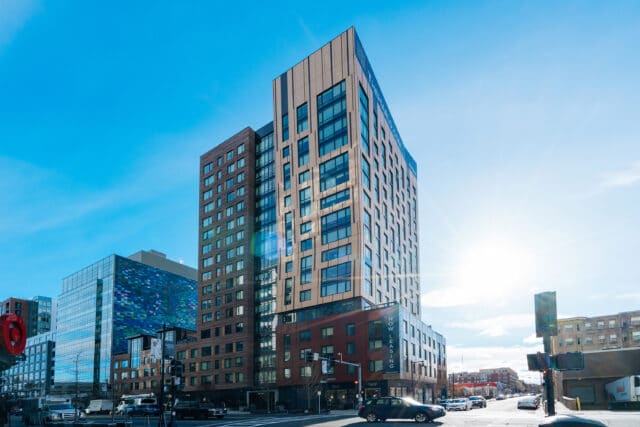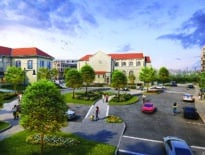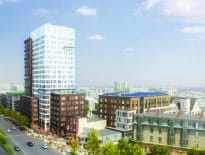
The Bower apartment complex, which is scheduled to open this summer near Fenway Park, has announced initial asking rents starting at $2,788 for studios and $3,200 for one-bedroom units. Image courtesy of The Architectural Team
Jon Cronin and Kelly Saito represent two ends of the spectrum assessing what COVID-19 means for luxury multifamily development designs.
Cronin’s St. Regis Residences, a $341 million condominium high-rise, is set to begin vertical construction atop a pier on the South Boston waterfront. With decisions on purchases of building equipment still months in the future, the Boston-based developer is still conferring with architects Elkus Manfredi on his choices of building equipment such as elevators and plumbing fixtures that reflect the latest and best practices in the unfolding pandemic.
“Everything is on the table. Our hope is the vaccine will be here within 12 months, in which case this will be in the rear-view mirror,” Cronin said.
Saito, whose firm is set to open the first 100-unit building at The Bower apartments near Fenway Park in July, has little flexibility making changes to building designs before the first residents’ moving vans arrive.
“If you’re in design, maybe you’d have more ability to make changes, and that’s something people are thinking about now: Do we put in more elevators than we used to?” said Saito, managing partner at developer Gerding Edlen.
Price Dips in Upper-Tier Properties
The stakes are high for developers who are wrestling with how to make high-density urban living attractive to potential buyers and tenants, amid lingering questions about the length of the pandemic and its effects on the housing market.
A new report by The Collaborative Cos., the Boston-based luxury residential brokerage, found that some of the city’s newest and most expensive luxury apartment complexes have taken the biggest hit during the pandemic. The biggest drops were at 28 Exeter at Newbury, where asking rents declined 12 percent to $3,575, and the two-year-old Harlo tower in the Fenway, down 9 percent to $3,450.
Occupancy at stabilized apartment complexes in Boston’s urban core dropped from 95.3 to 93.2 percent during April, as universities shut down for the semester and some residents moved elsewhere.
“Between the combination of the economic concerns and unemployment affecting people who are part of the rental pool and the challenges of the universities, you’ve seen a softening across the board,” said Sue Hawkes, managing director of The Collaborative Cos. “Boston hasn’t experienced that in five years, but there’s been a bit of an uptick. They backfilled the vacancies with concessions, and we’re starting to see a stabilization.”

The two-year-old Harlo saw the second-biggest decline in asking rents of any Boston luxury condominium project, post-pandemic, according to The Collaborative Cos. Image courtesy of Skanska USA
On the luxury condo side, average sales prices per square foot declined 6 percent from the previous year to $940 per square foot. Two of the highest-price condo submarkets, the waterfront and Seaport District, saw the biggest declines, with prices down 14 and 13 percent to $1,064 and $1,659 per square foot respectively.
But Back Bay, which leads the city with average prices approaching $2.2 million, saw a 5 percent price gain over the past 12 months, due mainly to sales at the One Dalton tower, Hawkes said.
A Chance to Clear the Air
The developer of Back Bay’s next luxury tower is taking COVID concerns into consideration prior to the beginning of vertical construction late this year. Boston-based Noannet Group has begun foundation work on its $400 million Raffles Boston Back Bay Hotel & Residences after demolishing the former Boston Common Hotel & Conference Center at 40 Trinity Place.
Noannet Group President Jordan Warshaw said he’s been having lengthy conversations with the project engineers and architects about changes to HVAC system designs. The goal is to deliver 100 percent–outside air into the 146 condo units, and maximize air changes in common area gathering spaces, Warshaw said.
“People are concerned about what they’re breathing, and what could be the next [health emergency] that could cause issues. It’s something people have been looking at before and after COVID,” Warshaw said.
Cronin said he is studying into installation of touchless bathroom fixtures at the St. Regis, which will contain 150 units in a 22-story tower.
“We’re looking at the new technologies that are being advanced due to this, and we’re fortunate that we have some time in the eight months before we need to purchase anything,” he said.

Steve Adams
Developers also are keeping an eye out for advances in elevator technology, including touchless operation that enable residents to summon cars via a mobile app, and systems that limit the number of occupants. So-called destination elevators, which have become more prevalent in new office towers, segregate elevator cars by desired floors, and can be programmed to limit access to specific floors based upon riders’ key cards.
The technology has potential to promote social distancing in multifamily buildings, Gerding Edlen’s Saito said.
“There are definitely operational challenges,” Saito said. “Believe me, we and everybody else are pressing [manufacturers] on when these systems will be available.”
UPDATED 8:51 a.m. 6/29/20: This story has been updated to correct descriptions of construction phases and design changes at the St. Regis Residences. The building is set to begin vertical construction soon after breaking ground in fall 2018. Touchless fixtures are being considered only for common areas and HVAC updates, while considered, are not currently planned.”




 |
| 

